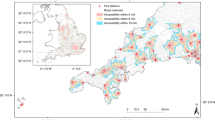Abstract
In light of recent events, there has been a surge in discussions of defunding police. On one hand, policy that reduces police presence aims to reduce frequency of police violence. On the other hand, downsizing the police force triggers concerns of public safety and police response time. In this work, we use spatial analysis to examine the impact a reduced police force may have on response time. Modeling the transportation system of Chicago as a network, we simulate the response of police officers from stations to incidents. We then use this simulation to calculate the impacts of resource re-allocation from police to alternate responders. Using Chicago’s large, open-source police incident response database, we use our simulation to predict how the response time changes subject to various crime and policing scenarios. Our model suggests that the current response time distribution can be maintained with a 30–60% reduction in police staffing levels if some incidents are re-allocated to alternate responders.





Similar content being viewed by others
Data availability statement
This manuscript has associated data in a data repository [Authors’ comment: The datasets generated during and/or analyzed during the current study are available in the author’s Github repository [https://github.com/callieclark/response-time-project].]
References
A. Sterling, Police killed over 1,000 American civilians in 2019. Forbes (2019) . https://www.forbes.com/sites/amysterling/2020/07/01/police-killed-over-1000-american-civilians-in-2019/?sh=5eb09e18667e
A. Jones, W. Sawyer, Not Just “A Few Bad Apples”: U.S. Police Kill Civilians at Much Higher Rates than Other Countries (Policy Initiative-Prison Policy, 2019)
S. Sinyangwe, Mapping police violence (2020). https://mappingpoliceviolence.org/
R. Ray, What Does ‘Defund the Police’ Mean and Does it Have Merit? (The Brookings Institution, 2020)
S. Holder, F. Akinnibi, C. Cannon, We Have Not Defunded Anything’: Big Cities Boost Police Budgets (Bloomberg, 2020)
J. Asher, B. Horwitz, How Do the Police Actually Spend Their Time? New York Times (2019)
M. De Nadai, Y. Xu, E. Letouzé et al., Sci. Rep. 10, 13871 (2020)
T. Bouhoun, Optimizing Ambulance Response Time Using Uber Movement Data (Towards Data Science,2019)
S. Saisubramanian, P. Varakantham, H.C. Lau, in Proceedings of the AAAI Conference on Artificial Intelligence, vol. 29, no. 1 (2015)
J. Lauritsen, N. White, Bureau of Justice Statistics (Seasonal Patterns in Criminal Victimization Trends, Special Report (2014)
Chicago Research and Development Division, 2011 Murder Analysis Report (2011)
J. McCabe, ICMA Center for Public Safety Management (How Many Officers do You Really Need, An Analysis of Police Department Staffing (2013)
Portland Police Bureau, Introduction to Calls for Service (2020). https://www.portlandoregon.gov/police/article/676725. Accessed 25 June 2021
E. Limpert, W.A. Stahel, M. Abbt, BioScience 51(5), 341–352 (2001)
U.S. Department of Justice, OJJDP Statistical Briefing Book (2018)
Albert-Laszlo. Barabasi, Nature 435, 207–211 (2005)
S.A. Sherman, Many Cities are Rethinking the Police, But What are the Alternatives? (Kinder Institute for Urban Research, Urban Edge, 2020)
J.D. Wood, A. Watson, A. Fulambarker, Police Q. 20, 81–105 (2017)
E. Westervelt, Removing Cops From Behavioral Crisis Calls: ’We Need To Change The Model’ (NPR.org, 2020)
G. Boeing, Comput. Environ. Urban Syst. 65, 126–139 (2017)
M. Eloy, Chicago Police Response Time is Down in 2012 (WBEX Chicago, 2012)
ACLU Illinois, Newly-Released Data Shows City Continues to Deny Equitable Police Services to South and West Side Neighborhoods (2014)
D. Fitzpatrick, W. Gorr, D. Neill, Annu. Rev. Criminol. 2, 473–491 (2019)
Acknowledgements
The original project idea was formulated and implemented with the stated authors, in collaboration with Preet Gill. We would also like to acknowledge the input and discussion from various individuals and institutions, including: Stephen Sherman at the Kinder Institute for Urban Research, Andrew Fan at the Invisible Institute, and the team at Law Enforcement Assisted Diversion (LEAD).This material is based on work supported by the National Science Foundation Graduate Research Fellowship Program under Grant No. DGE 1752814. Any opinions, findings, and conclusions or recommendations expressed in this material are those of the author(s) and do not necessarily reflect the views of the National Science Foundation or the above collaborators.
Author information
Authors and Affiliations
Corresponding author
Supplementary Information
Below is the link to the electronic supplementary material.
Rights and permissions
About this article
Cite this article
Clark, C., Dangwal, C., Kato, D. et al. A network spatial analysis simulating response time to calls for service at variable staffing levels. Eur. Phys. J. Spec. Top. 231, 1645–1653 (2022). https://doi.org/10.1140/epjs/s11734-021-00344-1
Received:
Accepted:
Published:
Issue Date:
DOI: https://doi.org/10.1140/epjs/s11734-021-00344-1




